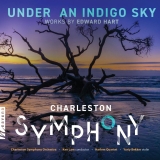In seinen Kompositionen A Charleston Concerto und Under an Indigo Sky befasst sich Edward Hart, ein Komponist aus South Carolina und Dekan der School of the Arts am College of Charleston, mit der Geschichte und Kultur des Südostens der Vereinigten Staaten.
Under an Indigo Sky für Violine und Orchester ist eine musikalische Hommage an Harts geografische Heimat. In den Sätzen Fast-Flowing Rivers, Warm Salt Air und Misty Blue Horizon beschreibt der Komponist sukzessiv das Inland mit seinen vielen Flüssen und Bächen, dann die Küste am ruhigen Meer beim Sonnenuntergang und schließlich die Pracht der Berge. Er tut das mit sehr evokativen musikalischen Mitteln in einer unmittelbar zugänglichen Tonsprache. Damit gelang Hart ein wirklich schönes, im langsamen zweiten Satz direkt bezauberndes Musikstück, das von Yuriy Bekker, und dem Charleston Symphony Orchestra unter Ken Lam sehr stimmungsvoll gespielt wird.
A Charleston Concerto wurde anlässlich des 350-jährigen Jubiläums der Stadt Charleston geschrieben und entstand in Zusammenarbeit mit dem Charleston Symphony und dem Harlem Quartet. Es « wirft einen schonungslosen, aber letztlich hoffnungsvollen Blick auf die komplexe Geschichte der Stadt in diesen dreieinhalb Jahrhunderten ».
Der erste Satz heißt Discovery, und hier stellt sich der Komponist « die Erfahrung der ersten Menschen vor, die auf den Hafen von Charleston blickten. Diese Gruppe von Eingeborenen mag durch den dichten subtropischen Wald gewandert sein und allmählich flüchtige Meeresbrisen und Sonnenstrahlen wahrgenommen haben, um dann ehrfürchtig die Wasserkante zu erreichen, die den herrlichen windgepeitschten Hafen offenbart und sie mit einem Gefühl der Ehrfurcht und des Optimismus erfüllt. »
Der zweite Satz, ‘Tragödie und Versöhnung’, und erinnert an
Naturkatastrophen, Kriege und « insbesondere die Versklavung unserer Mitmenschen und die anschließende schlechte Behandlung ihrer Nachkommen. » Worauf, Hoffnung bildend, die Versöhnung folgt.
Das ist ein besonders starker und spannungs- sowie ausdrucksvoller Satz. Die Musik basiert auf zwei Gullah Spirituals, einem Musikgenre, der Elemente westafrikanischer Aufführungspraxis mit Texten aus der Bibel verbindet.
Der Satz ‘Morgen’ beendet die Symphonie optimistisch.
Eine gute Interpretation und eine gut ausbalancierte Tonaufnahme lassen die Komposition zusätzlich attraktiv werden.
In his compositions A Charleston Concerto and Under an Indigo Sky, Edward Hart, a South Carolina composer and dean of the College of Charleston School of the Arts, explores the culture and history and civilization of the southeastern United States.
Under an Indigo Sky for violin and orchestra is a musical tribute to Hart’s geographic home. In the movements Fast-Flowing Rivers, Warm Salt Air, and Misty Blue Horizon, the composer successively describes the inland country with its many rivers and streams, then the coast by the calm sea at sunset, and finally the splendor of the mountains. He does this with very evocative musical devices in an immediately accessible tonal language. In doing so, Hart succeeded in creating a truly beautiful piece of music, directly enchanting in the slow second movement, played very atmospherically by Yuriy Bekker, and the Charleston Symphony Orchestra under Ken Lam.
A Charleston Concerto was written to commemorate the 350th anniversary of the city of Charleston, and was written in collaboration with the Charleston Symphony and the Harlem Quartet. It « takes an unsparing but ultimately hopeful look at the city’s complex history over these three and a half centuries. »
The first movement is called Discovery, and here the composer « imagines the experience of the first people to look out on Charleston Harbor. This group of natives may have wandered through the dense subtropical forest, gradually noticing fleeting sea breezes and rays of sunlight, and then reverently reached the water’s edge, which revealed the magnificent windswept harbor, filling them with a sense of awe and optimism. »
The second movement, ‘Tragedy and Reconciliation,’ and recalls natural disasters, wars, and « especially the enslavement of our fellow human beings and the subsequent ill treatment of their descendants. » Which, forming hope, is followed by reconciliation.
This is a particularly strong as well as expressive movement. The music is based on two Gullah Spirituals, a musical genre that combines elements of West African performance practice with texts from the Bible or inspired biblical passages.
The movement ‘Tomorrow’ ends the symphony on an optimistic note.
A good interpretation and a well-balanced sound recording make the composition additionally attractive.






















